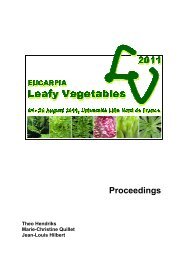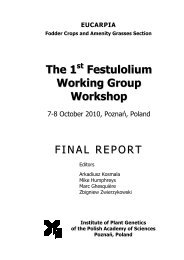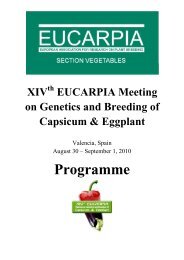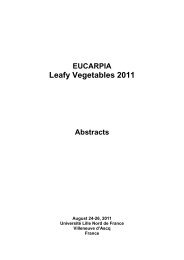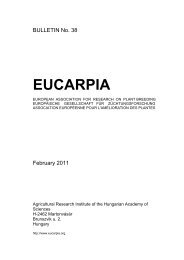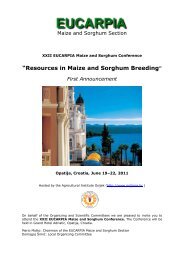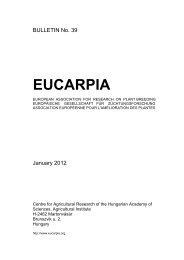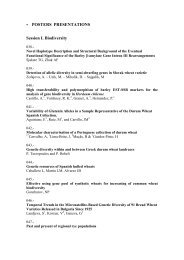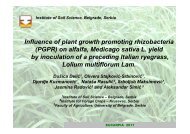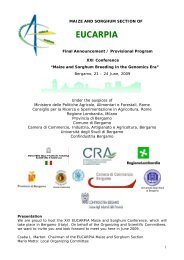Plant breeding for organic and sustainable, low-input agriculture
Plant breeding for organic and sustainable, low-input agriculture
Plant breeding for organic and sustainable, low-input agriculture
You also want an ePaper? Increase the reach of your titles
YUMPU automatically turns print PDFs into web optimized ePapers that Google loves.
Should resistance to harrowing be included as selection criteria <strong>for</strong> <strong>organic</strong> barley <strong>and</strong> oat<br />
varieties?<br />
Elisabeth Zechner 1 , Alex<strong>and</strong>ra Kinastberger 2<br />
1 Saatzucht Edelhof, Zwettl, Austria<br />
2 Verein zur Förderung der Mohn- und Getreidezüchtung, Zwettl, Austria<br />
Within the Austrian project „Basic principles <strong>for</strong> <strong>breeding</strong>, multiplication <strong>and</strong> variety testing <strong>for</strong><br />
<strong>organic</strong> <strong>agriculture</strong>” (financing body: Ministry of Agriculture <strong>and</strong> State Governments, 2004-<br />
2008) breeders do research <strong>for</strong> the development of new methods <strong>for</strong> the evaluation of suitable<br />
seeds <strong>and</strong> varieties <strong>for</strong> <strong>organic</strong> <strong>agriculture</strong>, so also research is done in “Tolerance to harrowing of<br />
spring barley <strong>and</strong> oats”. To combine the dem<strong>and</strong>s on powerful <strong>and</strong> healthy varieties <strong>for</strong> <strong>organic</strong><br />
farming with high quality it makes sense to select lines out of the wide range in a conventional<br />
<strong>breeding</strong> garden.<br />
At the Austrian location Edelhof near Zwettl 16 varieties of each spring barley <strong>and</strong> oats used in<br />
Austrian <strong>organic</strong> farming were grown to monitor their tolerance to harrowing in the years 2005<br />
to 2007. The drilling was done with 400 seeds/m². The monitoring consisted of two trials with<br />
each three replications, one trial had been harrowed <strong>and</strong> one trial without harrowing. Different<br />
criteria were noted e.g. growth rate, plant habit, plant length, reaction to the mechanical weed<br />
control, soil covering rate, ear emergence, diseases. After harvesting <strong>and</strong> weighting also several<br />
quality analysis had been carried out.<br />
Results<br />
• No - respectively only insignificant - differences between the same variety in harrowed <strong>and</strong><br />
not-harrowed model in ear emergence, maturity, soil covering, diseases<br />
• the not-harrowed model yielded better in three years <strong>for</strong> spring barley <strong>and</strong> spring oats<br />
• In most varieties the quality characters are going down<br />
• Only few varieties reacted positively to harrowing<br />
• But not in all years varieties react in the same way<br />
Although in the harrowed model less weed emerged, the competition of these weeds had no<br />
strong negative effects to the varieties in the not-harrowed model. The mobilisation of nutrients<br />
through the use of the harrow could not be realised <strong>for</strong> most of them. The harrowing could not<br />
generate higher monetary surpluses through higher yields or better qualities, respectively the<br />
harrowing seems to be an unnecessary work <strong>and</strong> expense at first glance. But as harrowing is<br />
necessary to keep under control the weed seed bank the breeder has to look <strong>for</strong> varieties resistant<br />
to harrowing <strong>and</strong> reacting also positively with higher yields <strong>and</strong> better quality. So far there are no<br />
shared characters found from the few positively reacting varieties useable as a selection criteria.<br />
45




